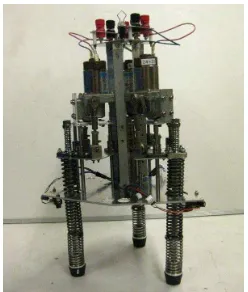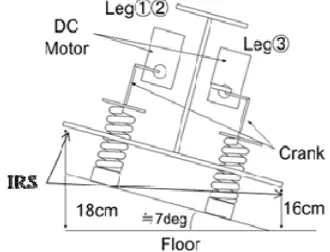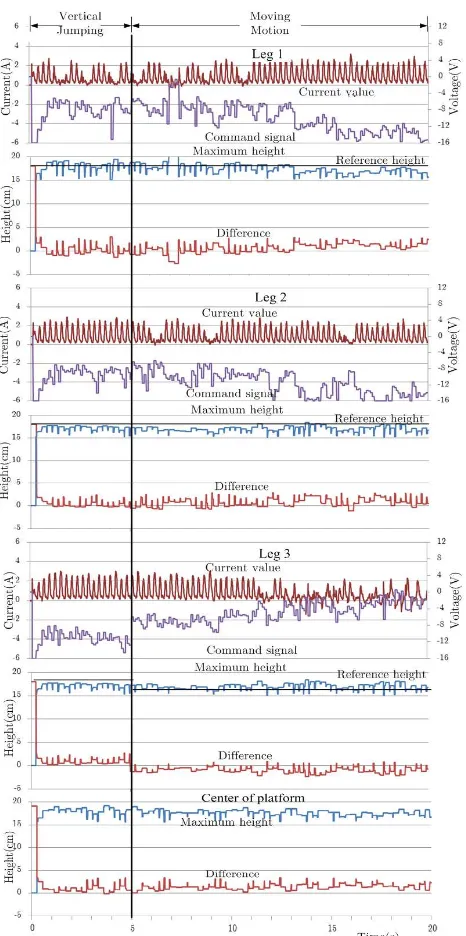Moving Motion Control System On Developed
Tripod Hopping Robot
A.M. Kassim, M.F.Miskon, N.H.A. Rahim Universiti Teknikal Malaysia Melaka, 76100 Durian Tunggal, Melaka, Malaysia
T.Yasuno
The University of Tokushima 2–1 Minamijosanjima–cho Tokushima, 770–8506 JAPAN [email protected]–u.ac.jp
Abstract—This paper discussed on evaluation and validation of method in order to generate the moving motion control system of the developed tripod hopping robot. The proposed method to control the system is designed by using MATLAB&Simulink which consist of reference height control system and the networks of Central Pattern Generator (CPG) that can controlled the hopping height of each leg independently. By using this method, one of the legs of the tripod hopping robot is set to different value than the other leg in order to make the posture of hopping robot’s body incline ahead towards to the direction which it should move, respectively. As the result, the effectiveness of the approached method to generate moving motion of the hopping robot using CPG networks that including the reference height control system is confirmed while maintain the stability of developed tripod hopping robot from tumbled ahead.
Keywords—moving motion control, tripod hopping robot, CPG networks, reference height control system
I. INTRODUCTION
Bio-inspired for robot locomotion has been greatly studied by a lot of researchers in the world in these three decades. The types of locomotion that have been studied mostly on legged type, crawling type and flying type locomotion. It is because of the mobility and adaptive motion control that can be achieved by using the bio-inspired method. However, by using this type of locomotion still have a lot of challenges that have to be solved such as complexity of control system, robustness and adaptive motion in various environments and complexity of robot construction. On the other hand, one of the locomotion that also has been focused is jumping type locomotion. Jumping type robot also can be classified in two kind of mechanism which is one big jump and rhythmical jump called hopping type mechanism.
M.H Raibert who has done research on one legged hopping robot is the main contributor of hopping robot research [1]. The first hopping robot invented consists of body and leg which is equipped with a pair of pneumatic actuators to exert torque between the leg and the body about to hip. Then, Koditscheck and Buhler have discovered the discrete dynamic system theory which analyzes the dynamics of a simplified hopping robot which focused on the vertical movement only [2]. Besides, I. Murakami et al. has done his research on hopping robot which control the hopping and moving motion by using the linear DC motor and the gyroscope for attitude control. The linear DC motor was designed into the body part and the leg part of the hopping robot and constructed the direct-drive hopping mechanism [3].
In addition, Okubo et al. has introduced the design of jumping machine using self-energizing spring. His research has produced a machine or robot which can achieve high jumping performance by using small output actuators [4]. Moreover, Tukagoshi et al. has studied on numerical analysis and design for higher jumping rescue robot by using a pneumatic cylinder. They had developed the leg in rotor type robot which can use in flatted smooth surface (wheeled locomotion) and overcome the irregular surface (jumping locomotion) [5]. Hence, the effectiveness of bio-inspired locomotion of robot also can be implemented by using bio-inspired control system such as neural networks, neural oscillator and etc that consisted non-linear control system as main brain of robot.
On the other hand, physiological experiments suggest that basic locomotors patterns of most living bodies such as walking, flapping, flying and swimming are generated by CPGs which generates rhythmic activities [6]. CPG is neural networks that can endogenously produce rhythmic patterned outputs; these networks underlie the production of most rhythmic motor patterns. The periodic activities of the CPG which are initiated by a burst from the higher motor centre induce the muscle activities. After the initiation of the locomotion, the activities of the CPG are affected by sensory signals which show the bending of the body and so on [7]. The proactive sensory feedback plays an important role in the shaping and coordination of the neural activity with the mechanical activity.
Additionally, neurophysiologic studies of insect locomotion suggest that sensory feedback is involved in patterning motor activities and that is more than modulation of the centrally generated pattern [8]. The construction of useful legged type locomotion comes from the system which is able to control joint motion, monitor and manipulate balance, generate motions to use known footholds, sense the terrain to find good footholds and calculate negotiable foothold sequences. Furthermore, Taga proposed a walking motion control mode in which neural oscillator interact with the sensory feedback signals from the musculoskeletal systems [9-10]. Then, by using the concept of walking motion control model suggested by Taga, Kimura proposed a method of structuring the coupling of neural and mechanical systems for the implementation of autonomous adaption through the irregular terrain [11]. Besides that, Son et al. proposed a CPG model including the motor dynamic characteristics of an actuator for the purpose of implementing generation adaptive gait patterns International Conference on Electrical, Control and Computer Engineering
Pahang, Malaysia, June 21-22, 2011
for a quadruped robot under various environments [12]. Meanwhile, Kondo et al. has developed the quadruped hopping robot which is used central pattern generators (CPGs) as pattern generator in order to generate the continuous jumping performance while control the stability of body balance [13-15].
In this paper, the generation of moving control while jumping continuously by using adaptive CPG networks is discussed. The proposed moving method for controlling the system is designed by using MATLAB&Simulink which included the reference height control system and the networks of Central Pattern Generator (CPG) that can controlled the hopping height of each leg independently. By using this method, each leg of the developed tripod hopping robot is set to different value from the other leg in order to make the posture of hopping robot’s body incline ahead towards to the direction which it should move, respectively.
II. DEVELOPEDTRIPOD HOPPING ROBOT
A. Robot Construction
Figure 1 shows the construction of the developed tripod hopping robot which its overall length and width is 26 cm, overall height is 40 cm and its weight is 4.59kg. The tripod hopping robot is consisting of three legs which are connected to a shared platform. A DC geared motor (12V, 200min-1, 0.098Nm), a crank and a spring are joined together to form a leg which is attached to the crankshaft.
Figure 1. Developed tripod hopping robot
DC geared motor plays as the main role of the tripod hopping robot performance. DC amplifier is used to drive the DC geared motor to provide torque through the crank to push the platform. Figure 2 presents the principle hopping mechanism of the developed tripod hopping robot. Periodical hopping motion of tripod hopping robot is achieved by converting the periodic force of motor torque to the spring. Floor repulsive force can be used to generate the continuous hopping motion of the tripod hopping robot applying suitable force at suitable time to the spring.
B. Experimental Setup
Figure 3 shows the experimental setup for evaluation of the tripod hopping robot. The system needs two different computers which are connected through Ethernet to each other.
Figure 2. Hopping mechanism
One of the computers is included with MATLAB&Simulink model functions as the host computer while the other one is functioning as xPC target computer. The model which built by Realtime workshop is downloaded to the xPC target computer and run by using Realtime OS. The measurement of sensor on each leg will be send to the A/D converter and input to the xPC target computer as the experimental results.
Figure 3. Experimental Setup
III. SYSTEM CONFIGURATION
A. CPG Model
Figure 4 shows the block diagram of the CPG model which is used for the tripod hopping robot. Mechanical dynamics of the leg is included into the inhibitory unit. Parameters ue and ui denotes the internal state of the excitatory unit and inhibitory unit, b and c denotes the intrinsic excitatory and inhibitory coupling parameter, a denotes the excitatory coupling factor while Bo denotes the constant bias input. The output of the inhibitory unit corresponds to the platform position of each leg and is applied to the excitatory unit through a nonlinear function tan-1 (ui) and the feedback gain b which is formulated as below.
Where f(*) is the mechanical dynamics of the hopping robot’s leg, Ka is the gain constant of the DC amplifier and d is the external disturbances which is the floor repulsive force for this case. CPG may change the amplitude and frequency of internal states ue and uiby only hanging the coupling parameters a, b, c,
the time constant τe and the mechanical dynamics of the hopping robot arbitrarily.
Figure 4. Block diagram of CPG model.
B. Moving Motion Control System
Figure 5 shows the block diagram of the reference height control system for one leg of developed tripod hopping robot which is consisted maximum height detector, PI controller and CPG built by using MATLAB&Simulink tool. By using the block diagram as the CPG networks, clock and switch block are applied to the MATLAB&Simulink model to change the reference height of leg 3 from 18cm to 16cm after the clock timing is 5second while reference height for leg 1 and leg 2 are remained 18cm.
Figure 5. Block diagram of reference height control system
Figure 6. Proposed moving method for tripod hopping robot
At this moment, leg 3 has been assumed as front leg and should jump lower than leg 1 and leg 2 in order to make the body posture inclined ahead to where it should move thus initiating the moving motion. The posture of moving method can be illustrated as figure 6.
C. CPG networks
Configuration of typical CPG network is shown in figure 7. Cooperative oscillations among the CPG is required and continuous hopping performance of the tripod hopping robot is achievable by applying the same periodic force to the spring of the robot.
Figure 7. CPG networks for tripod hopping robot
IV. EXPERIMENTAL RESULT
After The experiment are conducted in two dimensional which are one dimension for vertical jumping motion and the other one is forward moving motion. In this experiment, the reference height control system has been applied in order to control the reference hopping height for each leg of the developed tripod hopping robot. The internal parameters of CPGs are set to typical value as a=0.1, b=2, c=1, Bo=0.01,
τe=0.1, f=0.1 and PI controller’s gain are set as KP=1.0 and
KI=0.2 in order to generate the efficient hopping motion.
The experiment was conducted for 20 sec with reference hopping height for all legs are set to 18 cm at first 5 sec to maintain the oscillation hopping performances. After 5 sec, reference height for leg 3 is reduced to 16 cm which lead the leg to become at front position while the other two as rear position thus making the posture of the hopping robot’s body incline ahead towards the direction it should be moved. Figure 8 represents the experimental results for the moving motion control system of tripod hopping robot experiments. It represents four types of output signal which are maximum hopping height value hmax on each jump, signal of differences
(steady state error) hdiff, the command signal sent from DC
amplifier to the DC geared motor and the current values from the current sensors which are mounted on each DC geared motor of each leg.
The experimental results show that the developed tripod hopping robot is confirmed to attain the reference hopping height at the first 5 sec while hopping in vertical motion. After that, command signals and the current sensors value are changed in order to implement the moving performances following by the changes of reference height on each leg. Leg 3 which represents as front leg will try to achieve the reference height which has been reduced to 16 cm by decreasing the
power voltage value about 50% and oscillated around 4V to -8V. Meanwhile, the powers of the other two legs are maintained. From the experiments, the validity of CPG network system is confirmed which is functioned to maintain the stability of developed tripod hopping robot while moving and avoiding it from tumble ahead.
Figure 8. Experimental results for moving motion control system for tripod hopping robot.
V. CONCLUSIONS
In this paper, we have conducted the experiments on proposed moving method of the developed tripod hopping robot by using the reference height control system in order to control the moving motion control system while jumping continuously The direction of tripod hopping robot’s body inclination is affected by the difference of reference hopping
height on each leg of the tripod hopping robot. The effectiveness of CPG networks in order to generate continuous hopping motion and keep the stability of tripod hopping robot from tumble ahead is also confirmed.
In future, we aim to investigate and study on the changing of command signal which is not stable at the last period of experiment which affected the experimental results. Besides that, we would like to build simulation model for the tripod hopping robot and by using learning algorithm we aim to acquire the best value of CPGs parameters and coupling parameters of CPG networks for hopping at arbitrary place.
ACKNOWLEDGEMENT
This research is supported by research grant from Universiti Teknikal Malaysia Melaka award no. PJP/2010/FKE (25C) S726 and also technically support from Yasuno laboratory member, The University of Tokushima, Japan.
REFERENCES
[1] M.H Raibert; Legged Robot That Balance, MIT Press, Cambridge, Massachusetts, 1986
[2] D. E. Koditscheck and M. Buhler: Analysis of a simplified hopping robot, Int. Journal of Robotics Res., Vol.10(6), pp. 587–605, 1991. H. Kojima, I. Murakami, S. Yoshida, T. Sekiya: Development of Linear DC Motor surrounded by Four Faces for Hopping Robot and Experiments of Continuous Hopping, J. Robotics Soc. Japan, Vol.14(1), pp.91–95, 1994.(In Japanese)
[3] H. Okubo, E. Nakano: General Knowledgement on Jumping type robot, J. Robotics Soc. Japan, Vol.11(3), pp. 342–347, 1998.(In Japanese) [4] H. Tsukagoshi, M. Sasaki, A. Kitagawa, T. Tanaka: Numerical Analysis
and Design for Higher Jumping on Debris Using a Pneumatic Cylinder, Journal of The Society of Instrument and Control, Vol.40(8), pp. 859– 866, 2004.(In Japanese)
[5] Grillner S,Neurobiological Bases of Rhythmic Motor Acts Invertebrates, Science, Vol.228, pp.143-149, 1985.
[6] William TL, Sigvardt KA, Kopell N, Ermentrout GB, Remler MP; Forcing of Coupled Nonlinear Oscillator: Studies of Intersegmental Coordination in the Lamprey Locomotor Central Pattern Generator, Journal of Neurophysiol, No.64(3), pp 862-871, 1990.
[7] Bassler U; On the Definition of the Central Pattern Generator and its Sensory Control, Biol. Cybernatics, No.54, pp 65-69, 1986.
[8] Marder E and Calabrese RL: Principles of rhythmic motor pattern production, Physiological Reviews, No. 76, pp 687–717, 1996.
[9] G. Taga: A model of the neuro-musculo-skeletel system for human locomotion emergence of basic gait, Biol. Cybernetics, No.73,pp. 97– 111, 1995.
[10] G. Taga: A model of the neuro-musculo-skeletel system for human locomotion realtime adaptability under various constraints, Biol. Cybernetics, No.73, pp. 113–121, 1995.
[11] H. Kimura: Dynamic walking on irregular terrain and running on flat terrain of the quadruped using neural oscillator, J. Robotics Soc. Jpn., Vol.16, No.8, pp. 1138–1145, 1998.
[12] Y. Son, T. Kamano, T. Yasuno, T. Suzuki, and H. Harada: Generation of adaptive gait patterns for quadruped robot Using CPG Network, Electrical Eng. Jpn., Vol.115, No.1, pp. 35–43, 2006.
[13] K. Kondo, T. Yasuno and H. Harada: Generaton of jumping motion patterns for quadruped hopping robot using CPG network, Journal of Signal Processing, Vol.11,No.11,pp. 321–324, 2007.
Bin Mohamed Kassim. A.; T. Yasuno "The Moving Control of Quadruped Hopping Robot Using Adaptive CPG Networks"4th IEEE International Conference on Robotics, Automation and Mechatronics, Singapore, pp. 581-588, June 2010.


